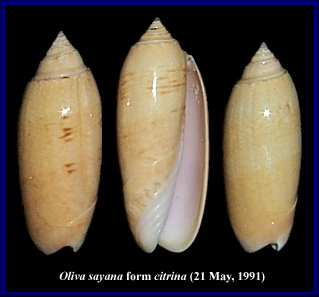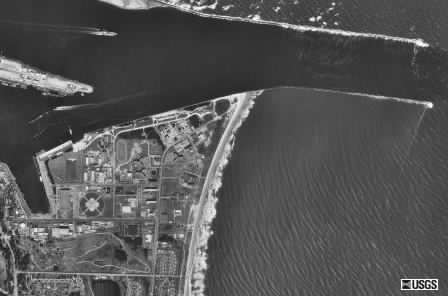| Beach Renourishment - Killer Of Shells? |
| By Bill Frank |
| You go to your local beach to collect, and
upon arrival you are flabbergasted by the seemingly countless
thousands of Oliva sayana
crawling upon the sand. It seems that you can't walk without
stepping on one of these active shiny mollusks, and, as far as
you can see, there is no change in their numbers. This is the
situation which confronted me at the beach at Mayport Naval
Station during the spring of 1991 - my first Spring collecting
experience at this location.
At first it was a wonderful collecting opportunity for an individual with only a couple of specimens in his collection. It soon became a quest for the largest or the "most golden (Oliva sayana form citrina)" of the thousands. Even casual collectors with five gallon buckets of olives (Filipinos apparently eat them) seemed to do little to stem this grunion-like assault on the beach. Time passed. This Oliva sayana glut became an annual phenomenon. During the next two years the numbers of olives appeared to even increase. It's hard to be sure, but on the best days, the visible population was estimated to be at least 5,000. Realistically, there are only so many times that you can bend over and check (count) a specimen. After a while your back sends you a clear message. This glut seemed to coincide with the spring minus tides of April/May; but in retrospect, rising water temperature (above 72 degrees F.) may have been the triggering factor. During the period, at times three Oliva sayana form citrina could be collected during a single day; with some 30 plus specimens found during the three-year period. While O. sayana form citrina are certainly rare, there is nothing like having thousands of specimens to peruse to increase the odds of success. These idyllic days all to suddenly came to an end. The next three years were a disaster olive population wise. Why - it's hard to say. While thousands of olives daily had been the norm, it suddenly was hundreds, and later, less than half of that. |
|
|
|
Satellite imagery (21 January, 1994) of the beach at Mayport Naval Station |
|
(St. Johns River and Jetties at top (north) of the image) |
| What caused the dramatic population change?
In the overall scheme of nature, a few years is literally just a
blink of the eye. This population change may not have any real
significance and be part of a natural cycle. However, from the
idyllic years to the present there are a couple events which are
noteworthy - both called beach renourishment. During the first such event (summer of 1994) the outer St. Johns River channel was dredged and the spoil pumped onto the beach at the naval station and adjacent Hanna Park. Much sea life (including O. sayana) was killed both during the dredging process and by the sedimentation that ensued. During the next year, the inner St. Johns River channel was dredged and, again, the resulting spoil was deposited on the naval station beach. While no shell (dead or alive) was found as a result of this project, again there was a significant change in the beach shape with considerable sedimentation. The year 1997 was again a disaster for the beach olive population (as well as for the other species commonly found in the same area Busycon perversum, Busycon carica, Triplofusus giganteus, etc.). The olive population was vigorously sampled on two prime dates (May 6th and May 20th); dates of the lowest spring tides with water temperature in the mid-seventy degree range. On the first date only 36 specimens were seen with the largest being a modest 68 mm. in length; quite small for the area. On the latter date only 24 specimens were seen with the largest a paltry 59 mm in length. Thus far during 1998, less than a dozen specimens have been found. Will this areas olive population ever rebound to that of the early 1990's? Only time will tell. However, with the increased strategic importance of Mayport Naval Station as well as expansion of Jacksonville's commercial port facilities, it would appear that further dredging is a virtual certainty. |

